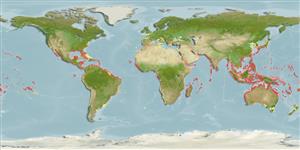Environment: milieu / climate zone / depth range / distribution range
Écologie
marin; océanodrome (Ref. 51243); profondeur 0 - 20 m. Subtropical; 44°N - 36°S, 180°W - 180°E
Widespread in tropical and subtropical zones of all oceans including the western Mediterranean Sea and part of the Caribbean Sea (Ref. 3720), probably absent in the inland seas of southeastern Asia (Sulawesi Sea, Sulu Sea, Flores, Banda, Ceram and Halmahera seas (Ref. 27313)), and the Benguela Current (Ref. 4498). Eastern Pacific: Mexico to central Chile; also the Galapagos and Hawaii. Western Pacific: Japan, Marshall Islands, Philippines, Australia (Ref. 5530), and Tahiti.
Taille / Poids / Âge
Maturity: Lm ? range ? - ? cm
Max length : 30.0 cm TL mâle / non sexé; (Ref. 9987); common length : 20.0 cm TL mâle / non sexé; (Ref. 5217)
Épines dorsales (Total) : 0; Rayons mous dorsaux (Total) : 12 - 15; Épines anales: 0; Rayons mous anaux: 12 - 14; Vertèbres: 43 - 46. Body dark, iridescent blue above, silvery white below; pectorals and caudal fin greyish, other fins not pigmented (Ref. 2797). Juveniles with or without black bars (Ref. 2797). Branchiostegal rays: 9-11 (Ref. 36606).
Adults occur in surface waters, both near and far from the coast (Ref. 5217). Form schools. Capable of leaping out of the water and gliding for long distances above the surface. Feed mostly on crustaceans and other planktonic animals. Preyed upon by swordfish, tunas and many other larger pelagic fishes (Ref. 9987). Oviparous, with planktonic eggs and larvae (Ref. 36606).
Parin, N.V., 1996. On the species composition of flying fishes (Exocoetidae) in the West-Central part of tropical Pacific. J. Ichthyol. 36(5):357-364. (Ref. 27313)
Statut dans la liste rouge de l'IUCN (Ref. 130435: Version 2024-1)
Menace pour l'homme
Harmless
Utilisations par l'homme
Pêcheries: commercial
Outils
Articles particuliers
Télécharger en XML
Sources Internet
Estimates based on models
Preferred temperature (Ref.
123201): 23.2 - 29.2, mean 27.9 °C (based on 4828 cells).
Phylogenetic diversity index (Ref.
82804): PD
50 = 0.5312 [Uniqueness, from 0.5 = low to 2.0 = high].
Bayesian length-weight: a=0.00631 (0.00288 - 0.01384), b=3.05 (2.85 - 3.25), in cm total length, based on LWR estimates for this (Sub)family-body shape (Ref.
93245).
Niveau trophique (Ref.
69278): 3.0 ±0.09 se; based on food items.
Résilience (Ref.
120179): Haut, temps minimum de doublement de population inférieur à 15 mois (Preliminary K or Fecundity.).
Fishing Vulnerability (Ref.
59153): Low vulnerability (20 of 100).
